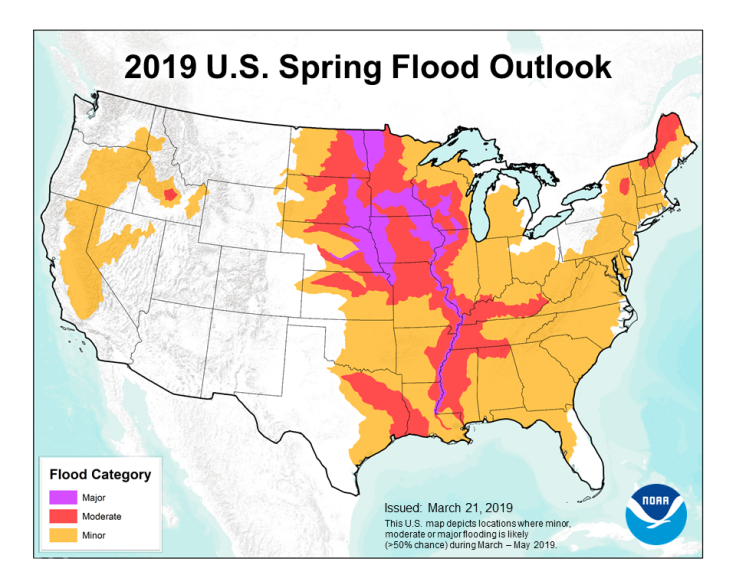‘Historic’ Floods Possible In Several Southern States In 2019 Spring, NOAA Warns

The National Oceanic and Atmospheric Administration reported Thursday that the winter’s deadly flooding had the potential to turn into a catastrophic spring flooding in the southern states and the Midwest.
NOAA’s spring outlook contained dire warnings, saying the recent flooding that hit several states — Nebraska, Iowa and Missouri — was just a glimpse of what may come next.
“We expect the flooding to get worse and become more widespread. The stage is set for record flooding now through May,” Mary Erikson, deputy director of NOAA’s National Weather service, said. She also said that the flooding could possibly be worse than the devastating floods of 1993 and 2011.
According to Edward Clark, director of NOAA’s National Water Center, “The extensive flooding we’ve seen in the past two weeks will continue through May and become more dire and may be exacerbated in the coming weeks as the water flows downstream. This is shaping up to be a potentially unprecedented flood season with more than 200 million people at risk for flooding in their communities.”
Officials also said that around two-thirds of the country will probably experience the floods and the areas of greatest risk for moderate to severe flooding included the upper, middle and lower Mississippi River basins, the mainstream Mississippi River, Red River of the North, the Great Lakes, eastern Missouri River, lower Ohio, lower Cumberland and Tennessee River basins.

“Major flooding causes extensive inundation of structures and roads and it frequently requires evacuation in the low-lying areas,” the National Weather Service said.
At least four people were killed and over 2,000 homes destroyed in the floods that began last week, resulting in the estimated loss of more than $1.5 billion. Officials believe the flood was a result of the rapid snow melt and the heavy spring rain, which could get worse over time.The late season snow fall in areas where the ground was already moist added to the flooding. Most of the precipitation fell during the “bomb cyclone” that hit the Midwestern region last week.
The floods in upper Mississippi and Missouri River basins had the early flooding due to the rapid snow melt combined with heavy rain and late season snowfall in areas where the soil moisture was high. Some areas it was the ice jams that made the floods worse. The flooding will expand and prolong increasing the flood threat, making it more widespread geographically as the excess water will flow downstream through river basins.
The severe rain and snow in California pulled the state out of its seven-year drought, however, several areas in Southwest, Southeast and Pacific Northwest were reported to be abnormally dry. The worst drought conditions being recorded in northern New Mexico. The conditions improved slightly after the rain and the melting snowpack.
Daniel Kanieski, deputy administrator of the Federal Emergency Management Agency said advised people in the high risk areas to have a flood insurance and also stressed on the importance of flood preparedness. “Severe weather and flooding can strike anywhere, whether or not you are in a high risk area. Insurance is the first and best line of defense,” he said.
© Copyright IBTimes 2024. All rights reserved.





















